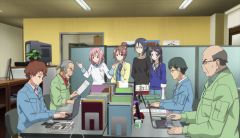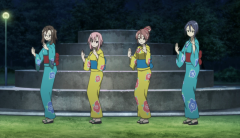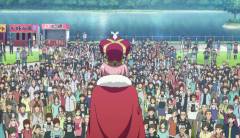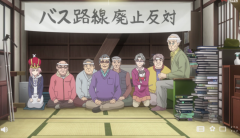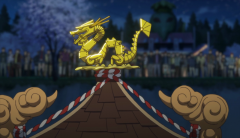Conceived as a third installment in a loose P.A Works trilogy about young adult girls in working environment, Sakura Quest both knows its target audience well, and has some big shoes to fill. After all, many have considered Shirobako an install classic for good reasons. As it turns out, Sakura Quest is more on the level of Iroha than Shirobako, and it still has some of the same issues from its predecessors, namely it’s still too optimistic, hence comes off as sometimes unrealistic outlook to its subject matters; and it tends to rely on sitcom slice of life format (mainly in the first half) that feels unfocused and inconsistent at times. Despite these issues, the truth remains that Sakura Quest had never been bad. The show has some snappy, realistic dialogues, easy humors and it never treats their characters lightly. The show is at its best when it creates problems that force the main cast to reflect on their own issues, then learn and grow from their own issues.
Sakura Quest’s structure is split into two distinct halves. The first half focuses on several mini-arcs, where the Tourism Boards undergo many events that attract more tourists visiting Manoyama, at the same time give each of the main girl a character arc to flesh out who they are. Many events, from assisting filming production, matchmaking tours, to the TV programs about our girls and hosting a popular rock band to town, are exciting and at first glance, it gives an illusion that the Tourist Board has achieved its success. In part, yes, as the number of visitors consistently goes up, but when all is said and done, the town remains a ghost town with no lasting impact whatsoever (I love this image: the next morning, all the tourists are gone, only trash and coupons flying around). The decision to concentrate on main leads’ own problems and their dynamic together in the first cour, now in retrospect, actually serves its purpose since we come to care and root for them well before the second cour pushes forward its main storyline.
If you consider the first cour as “inward approach” (forgive me for the lack of more academic term), which is attracting tourists to visit Manoyama town, the latter half can be seen as “outward approach”, as the Tourism Board reaches to the local needs, goes to rural mountain where a small elderly community lives, reviving an abandoned school for public use, and strengthen Shopping District’s business. For me, it’s a much more realistic approach and the journeys along the way are all worth spending time for. You can compare two festivals – the Manoyama Founding festival and the revival Mizuchi festival for their differences in approach. The Mizuchi festival is made for the locals, by the local and achieving that level of enthusiasm from the villagers is something worth rewarding. While there are still some unnecessary plot points (here looking at you the merger of Manoyama town), Sakura Quest did indeed end on a satisfying note. This might be the end of the Queen’s run and all other girls, but it’s clear that it’s just a beginning for the Manoyama’s local to grow stronger.
Our five girls: Yoshino, Sanae, Maki, Ririko and Shiori play a big part of adding Sakura Quest’s identity. All these girls have their own charms, play off well with each other, and most of own develop greatly at the end of the show. Sakura Quest’s biggest strength lies in its ability to address the insecurity of young adults regarding their jobs, their place to belong, and their choices of life. Many issues it touches (most notably Maki’s unsuccessful acting job) feel achingly true and honest. The supporting cast, from Kadota, Chitose, to that kid Erika, add their own marks to the show’s big picture and it’s a joy to watch such a huge cast coming together for a big project. I bet Sandal-san will enjoy a great fan following as he steals the scene every time he appears onscreen. Thanks Alexandre Cena Davis Celibidache for compiling such a fantastic artbook about Sakura Quest.
P.A Works does a pretty decent job production-wise for Sakura Quest, although in some episodes (especially the final episode) the character models are a bit off. The soundtrack and the voice acting are all pretty spot on. Only a year has passed in this Manoyama town but it has been quite a journey. Every girl has their own dream to follow now, and life continues to go on and I know there will be a time that the five of them will meet again under that sakura tree they planted together. As a conclusion, allow me to quote the final preview speech from Sandal-san because it sums what I feel so well: “It was a long, long trip, and we’re coming finally to the end of the journey. Thank you, Manoyama and Chupacabra. And thank you, 5 EURO”

